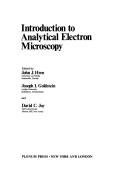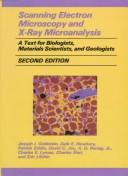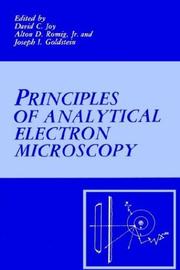| Listing 1 - 10 of 11 | << page >> |
Sort by
|
Book
ISBN: 0306308207 1461344247 1461344220 9780306308208 Year: 1977 Publisher: New York Plenum
Abstract | Keywords | Export | Availability | Bookmark
 Loading...
Loading...Choose an application
- Reference Manager
- EndNote
- RefWorks (Direct export to RefWorks)
Experimental solid state physics --- Spectrometric and optical chemical analysis --- fysicochemie --- Biological microscopy --- Microprobe analysis --- Analysis, Microprobe --- Probes (Electronic instruments) --- Scanning electron microscopy --- Electron microscopy --- Microchemistry --- Scanning electron microscopes --- Microscopes électroniques à balayage --- Microscope electronique
Book
Year: 1978 Publisher: Washington (D.C.): Smithsonian institution press
Abstract | Keywords | Export | Availability | Bookmark
 Loading...
Loading...Choose an application
- Reference Manager
- EndNote
- RefWorks (Direct export to RefWorks)
Book
Year: 1978 Publisher: Washington Smithsonian Institution Press
Abstract | Keywords | Export | Availability | Bookmark
 Loading...
Loading...Choose an application
- Reference Manager
- EndNote
- RefWorks (Direct export to RefWorks)
Book
Year: 1978 Publisher: Washington Smithsonian Institution Press
Abstract | Keywords | Export | Availability | Bookmark
 Loading...
Loading...Choose an application
- Reference Manager
- EndNote
- RefWorks (Direct export to RefWorks)

ISBN: 0306402807 147575583X 1475755813 Year: 1979 Publisher: New York, N.Y. Plenum Press
Abstract | Keywords | Export | Availability | Bookmark
 Loading...
Loading...Choose an application
- Reference Manager
- EndNote
- RefWorks (Direct export to RefWorks)
Experimental solid state physics --- Spectrometric and optical chemical analysis --- fysicochemie --- Biological microscopy --- Microscopy, Electron --- Electron microscopy --- Microscopie électronique --- 621.385 --- 620.18 --- Microscopy --- Apparatus employing electron discharges. Electron tubes. Thermionic vacuum tubes (thermionic valves) --- Investigation of structure of materials. Metallography. Analogous study of non-metals --- Electron microscopy. --- 620.18 Investigation of structure of materials. Metallography. Analogous study of non-metals --- 621.385 Apparatus employing electron discharges. Electron tubes. Thermionic vacuum tubes (thermionic valves) --- Microscopie électronique --- Microscopy, Electron.
Book
ISBN: 030640768X 1461332753 1461332737 9780306407680 Year: 1984 Publisher: New York Plenum
Abstract | Keywords | Export | Availability | Bookmark
 Loading...
Loading...Choose an application
- Reference Manager
- EndNote
- RefWorks (Direct export to RefWorks)
537.533.35 --- 543.063 --- 549.08 --- Scanning electron microscopy --- Electron microscopy --- Analytical chemistry--?.063 --- Mineralogy. Special study of minerals--?.08 --- 549.08 Mineralogy. Special study of minerals--?.08 --- 543.063 Analytical chemistry--?.063 --- 537.533.35 Electron microscopy --- Aftastmicroscoop [Elektronische ] --- Microscope electronique a balayage --- Scanning electron microscope --- Spectroscopie par rayons X --- X-ray spectroscopie --- X-ray spectroscopy --- X-ray microanalysis --- Microprobe analysis --- Experimental solid state physics --- Spectrometric and optical chemical analysis --- fysicochemie --- Microscope electronique --- Microscopes electroniques a balayage --- Rayon x

ISBN: 0306441756 1461276535 1461304911 9780306441752 Year: 1992 Publisher: New York Plenum Press
Abstract | Keywords | Export | Availability | Bookmark
 Loading...
Loading...Choose an application
- Reference Manager
- EndNote
- RefWorks (Direct export to RefWorks)
Scanning electron microscopy. --- X-ray microanalysis. --- Scanning electron microscopy --- X-ray microanalysis --- 537.533.35 --- 543.063 --- 549.08 --- Electron microscopy --- 537.533.35 Electron microscopy --- 549.08 Mineralogy. Special study of minerals--?.08 --- Mineralogy. Special study of minerals--?.08 --- 543.063 Analytical chemistry--?.063 --- Analytical chemistry--?.063 --- Microprobe analysis --- Experimental solid state physics --- Spectrometric and optical chemical analysis --- fysicochemie --- SCANNING ELECTRON MICROSCOPY --- Monograph

ISBN: 0306423871 Year: 1989 Publisher: New York Plenum Press
Abstract | Keywords | Export | Availability | Bookmark
 Loading...
Loading...Choose an application
- Reference Manager
- EndNote
- RefWorks (Direct export to RefWorks)
Book

ISBN: 1493966766 149396674X 9781493966745 Year: 2018 Publisher: New York, NY : Springer New York : Imprint: Springer,
Abstract | Keywords | Export | Availability | Bookmark
 Loading...
Loading...Choose an application
- Reference Manager
- EndNote
- RefWorks (Direct export to RefWorks)
This thoroughly revised and updated Fourth Edition of a time-honored text provides the reader with a comprehensive introduction to the field of scanning electron microscopy (SEM), energy dispersive X-ray spectrometry (EDS) for elemental microanalysis, electron backscatter diffraction analysis (EBSD) for micro-crystallography and focused ion beams. Students and academic researchers will find the text to be an authoritative and scholarly resource, while SEM operators and a diversity of practitioners — engineers, technicians, physical and biological scientists, clinicians, and technical managers — will find that every chapter has been overhauled to meet the more practical needs of the technologist and working professional. In a break with the past, this Fourth Edition de-emphasizes the design and physical operating basis of the instrumentation, including the electron sources, lenses, detectors, etc. In the modern SEM, many of the low level instrument parameters are now controlled and optimized by the microscope’s software, and user access is restricted. Although the software control system provides efficient and reproducible microscopy and microanalysis, the user must understand the parameter space wherein choices are made to achieve effective andmeaningful microscopy, microanalysis, and micro-crystallography. Therefore, special emphasis is placed on beam energy, beam current, electron detector characteristics and controls, and ancillary techniques such as energy dispersive x-ray spectrometry (EDS) and electron backscatter diffraction (EBSD). With 13 years between the publication of the third and fourth editions, new coverage reflects the many improvements in the instrument and analysis techniques. The SEM has evolved into a powerful and versatile characterization platform in which morphology, elemental composition, and crystal structure can be evaluated simultaneously. Extension of the SEM into a "dual beam" platform incorporating both electron and ion columns allows precision modification of the specimen by focused ion beam milling. New coverage in the Fourth Edition includes the increasing use of field emission guns and SEM instruments with high resolution capabilities, variable pressure SEM operation, theory, and measurement of x-rays with high throughput silicon drift detector (SDD-EDS) x-ray spectrometers. In addition to powerful vendor- supplied software to support data collection and processing, the microscopist can access advanced capabilities available in free, open source software platforms, including the National Institutes of Health (NIH) ImageJ-Fiji for image processing and the National Institute of Standards and Technology (NIST) DTSA II for quantitative EDS x-ray microanalysis and spectral simulation, both of which are extensively used in this work. However, the user has a responsibility to bring intellect, curiosity, and a proper skepticism to information on a computer screen and to the entire measurement process. This book helps you to achieve this goal. Realigns the text with the needs of a diverse audience from researchers and graduate students to SEM operators and technical managers Emphasizes practical, hands-on operation of the microscope, particularly user selection of the critical operating parameters to achieve meaningful results Provides step-by-step overviews of SEM, EDS, and EBSD and checklists of critical issues for SEM imaging, EDS x-ray microanalysis, and EBSD crystallographic measurements Makes extensive use of open source software: NIH ImageJ-FIJI for image processing and NIST DTSA II for quantitative EDS x-ray microanalysis and EDS spectral simulation. Includes case studies to illustrate practical problem solving Covers Helium ion scanning microscopy Organized into relatively self-contained modules – no need to "read it all" to understand a topic Includes an online supplement—an extensive "Database of Electronic–Solid Interactions"—which can be accessed on SpringerLink, in Chapter 3.
Materials science. --- Spectroscopy. --- Microscopy. --- Physical measurements. --- Measurement. --- Materials Science. --- Characterization and Evaluation of Materials. --- Spectroscopy and Microscopy. --- Biological Microscopy. --- Spectroscopy/Spectrometry. --- Measurement Science and Instrumentation. --- Measuring --- Mensuration --- Mathematics --- Technology --- Metrology --- Physical measurements --- Measurements, Physical --- Mathematical physics --- Measurement --- Analysis, Microscopic --- Light microscopy --- Micrographic analysis --- Microscope and microscopy --- Microscopic analysis --- Optical microscopy --- Optics --- Analysis, Spectrum --- Spectra --- Spectrochemical analysis --- Spectrochemistry --- Spectroscopy --- Chemistry, Analytic --- Interferometry --- Radiation --- Wave-motion, Theory of --- Absorption spectra --- Light --- Spectroscope --- Material science --- Physical sciences --- Qualitative --- Surfaces (Physics). --- Physics --- Surface chemistry --- Surfaces (Technology) --- Scanning electron microscopy --- X-ray microanalysis --- Microscopy, Electron, Scanning --- Electron Scanning Microscopy --- Scanning Electron Microscopy --- Electron Microscopies, Scanning --- Electron Microscopy, Scanning --- Electron Scanning Microscopies --- Microscopies, Electron Scanning --- Microscopies, Scanning Electron --- Microscopy, Electron Scanning --- Microscopy, Scanning Electron --- Scanning Electron Microscopies --- Scanning Microscopies, Electron --- Scanning Microscopy, Electron --- Microprobe analysis --- Electron microscopy --- Spectrometry --- Scanning electron microscopy. --- X-ray microanalysis. --- Measurement . --- Analytical chemistry
Digital

ISBN: 9781493966769 Year: 2018 Publisher: New York, NY Springer
Abstract | Keywords | Export | Availability | Bookmark
 Loading...
Loading...Choose an application
- Reference Manager
- EndNote
- RefWorks (Direct export to RefWorks)
This thoroughly revised and updated Fourth Edition of a time-honored text provides the reader with a comprehensive introduction to the field of scanning electron microscopy (SEM), energy dispersive X-ray spectrometry (EDS) for elemental microanalysis, electron backscatter diffraction analysis (EBSD) for micro-crystallography and focused ion beams. Students and academic researchers will find the text to be an authoritative and scholarly resource, while SEM operators and a diversity of practitioners — engineers, technicians, physical and biological scientists, clinicians, and technical managers — will find that every chapter has been overhauled to meet the more practical needs of the technologist and working professional. In a break with the past, this Fourth Edition de-emphasizes the design and physical operating basis of the instrumentation, including the electron sources, lenses, detectors, etc. In the modern SEM, many of the low level instrument parameters are now controlled and optimized by the microscope’s software, and user access is restricted. Although the software control system provides efficient and reproducible microscopy and microanalysis, the user must understand the parameter space wherein choices are made to achieve effective andmeaningful microscopy, microanalysis, and micro-crystallography. Therefore, special emphasis is placed on beam energy, beam current, electron detector characteristics and controls, and ancillary techniques such as energy dispersive x-ray spectrometry (EDS) and electron backscatter diffraction (EBSD). With 13 years between the publication of the third and fourth editions, new coverage reflects the many improvements in the instrument and analysis techniques. The SEM has evolved into a powerful and versatile characterization platform in which morphology, elemental composition, and crystal structure can be evaluated simultaneously. Extension of the SEM into a "dual beam" platform incorporating both electron and ion columns allows precision modification of the specimen by focused ion beam milling. New coverage in the Fourth Edition includes the increasing use of field emission guns and SEM instruments with high resolution capabilities, variable pressure SEM operation, theory, and measurement of x-rays with high throughput silicon drift detector (SDD-EDS) x-ray spectrometers. In addition to powerful vendor- supplied software to support data collection and processing, the microscopist can access advanced capabilities available in free, open source software platforms, including the National Institutes of Health (NIH) ImageJ-Fiji for image processing and the National Institute of Standards and Technology (NIST) DTSA II for quantitative EDS x-ray microanalysis and spectral simulation, both of which are extensively used in this work. However, the user has a responsibility to bring intellect, curiosity, and a proper skepticism to information on a computer screen and to the entire measurement process. This book helps you to achieve this goal. Realigns the text with the needs of a diverse audience from researchers and graduate students to SEM operators and technical managers Emphasizes practical, hands-on operation of the microscope, particularly user selection of the critical operating parameters to achieve meaningful results Provides step-by-step overviews of SEM, EDS, and EBSD and checklists of critical issues for SEM imaging, EDS x-ray microanalysis, and EBSD crystallographic measurements Makes extensive use of open source software: NIH ImageJ-FIJI for image processing and NIST DTSA II for quantitative EDS x-ray microanalysis and EDS spectral simulation. Includes case studies to illustrate practical problem solving Covers Helium ion scanning microscopy Organized into relatively self-contained modules – no need to "read it all" to understand a topic Includes an online supplement—an extensive "Database of Electronic–Solid Interactions"—which can be accessed on SpringerLink, in Chapter 3.
Measuring methods in physics --- Optics. Quantum optics --- Physics --- Surface chemistry --- Theoretical spectroscopy. Spectroscopic techniques --- Biological microscopy --- Materials sciences --- Chemical technology --- elektronenmicroscopie --- meetmethoden --- materiaalkennis --- biologische technieken --- oppervlakte-onderzoek --- spectroscopie --- microscopie --- spectrometrie
| Listing 1 - 10 of 11 | << page >> |
Sort by
|

 Search
Search Feedback
Feedback About UniCat
About UniCat  Help
Help News
News